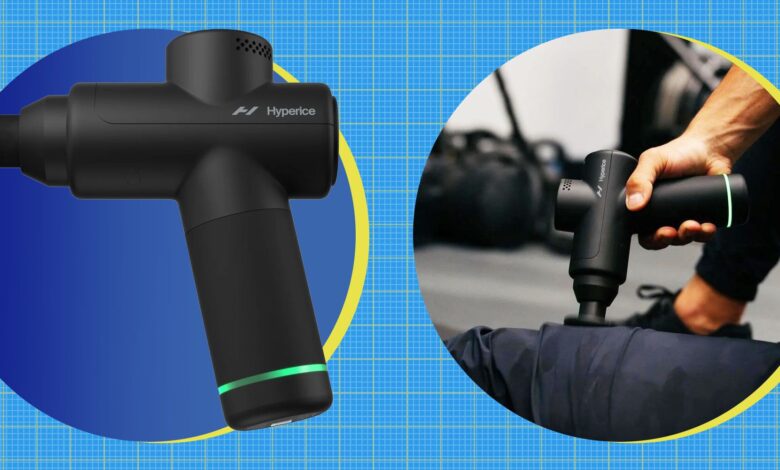Hyperice Hypervolt Go 2 Review: This Travel-Friendly Massage Gun Is All You Need

THE MASSAGE GUN has become the staple recovery tool among professional athletes and weekend warriors, who do everything from running to golfing to Brazilian jiu-jitsu to weight training. Demand breeds innovation, and a few years later, major recovery brands like Therabody and Hyperice innovated on Gen One massage guns, making them lighter and smaller without sacrificing power and speed.
Released in 2022, the Hypervolt Go 2 is Hyperice’s most compact massage gun. Overall, the Go 2 is about as powerful and effective as any full-sized massage gun on the market, but it weighs less, is as quiet as a massage gun can be (based on the ones I’ve used), and costs a good amount less than other top models.
Pros
- It’s pretty affordable compared to other massage guns
- Considerably lighter than Hypervolt 2 Pro
- Easy to use
Cons
- Marginally more compact than the Hypervolt 2
- Doesn’t come with a carrying case
| Product Weight | 1.5 lbs |
|---|---|
| Battery Life | 3 hours |
| Box Includes | 1 massage gun, 1 USB-C charger, and 2 massage heads |
Massage guns are handheld devices that utilize percussive therapy to break up adhesions (or scar tissue) in the muscle so your joints and muscles can move more freely. Athletes and gym-goers alike use them to warm up their muscles, improve mobility before a workout, and help reduce muscle soreness after a hard training session.
“In my PT practice, massage guns are one tool in our toolbox. They’re great for loosening tight muscles before manual therapy or exercises,” says Dr. Alyssa Burkitt, PT, DPT, H&W L1 of Bespoke Physical Therapy in San Diego. “They help patients feel better quickly, but the real progress comes from combining them with proper movement training and strengthening.”
To create that tissue-pounding pressure, the head of a massage gun rapidly retracts and protracts to strike your muscles. Three primary measurements determine the effectiveness of a massage gun: stall force, speed, and amplitude. Here’s why each matters.
- Stall Force: Massage gun manufacturers provide a measurement for no-stall force, which tells you how much pressure (measured in pounds) you can apply to the head before it stops moving. Depending on the size and model of the massage gun, most models provide no-stall force between 20 to 60 pounds.
- Speed: The RPMs (or revolutions per minute) measure how many strikes the massage gun delivers in 60 seconds, which contributes to the overall force and power of the percussive massage. Typically, most massagers have RPMs between 1,500 and 2,500, with some models going as fast as 3,500 RPMs.
- Amplitude: This measures the depth of each strike, also known as stroke length. The general amplitude for most massage guns ranges between 10 millimeters (mm) and 16mm. Massage guns with a shorter stroke length typically have a higher RPM and create more vibration on the muscle, while guns with a longer stroke length have a lower RPM and strike the muscle with a deeper impact.
That’s a lot of technical jargon, but having a basic understanding of how massage guns work can help you choose a model that best suits your preferences. If you want a deeper tissue massage, opt for a massager with more no-stall force and a longer stroke length. Or, buy a massage gun with high RPMs if you prefer a vibratory massage.
All that said, I have used many different massage guns and recently tested five top-of-the-line models for Men’s Health. As long as a massage gun is within the typical range for any of these categories, they tend to feel relatively similar. Pick one that fits your budget, travels well, and is comfortable to hold. Rest assured that you’re not missing the primary benefits of percussive therapy because you picked one massage gun brand over another.
Are Massage Guns Effective?
There’s not a ton of literature on massage guns, but there’s some evidence they increase flexibility and decrease muscle soreness in the short term. One study published in The Journal of Functional Morphology and Kinesiology concluded that massage guns could “improve short-term range of motion, flexibility, and recovery-related outcomes.” Another study says that because percussive therapy temporarily increases a muscle’s range of motion those muscles are less susceptible to injury.
So what does this mean in application? “I generally recommend using massage guns both ways—lightly before workouts to warm up muscles and increase range of motion, then more thoroughly after exercise to help with recovery,” Burkitt says. “Keep pre-workout use brief (one to two minutes per area) so you don’t overly relax the muscles before training.”
Before penning this review, I used my Hypervolt Go 2 before Brazilian Jiu-Jitsu and kickboxing classes, and my muscles felt more pliable than on the days I only performed my go-to dynamic warm-up. Using the massage gun on my sore shoulders and legs didn’t make them any less sore, but it felt good and helped me chill out as I watched TV at the end of my day. “While it’s not a miracle tool, I definitely notice less muscle soreness and stiffness when I take the time to use [my massage gun] consistently,” Burkitt adds. “The key is being gentle and not overdoing it.”
Setting Up the Hypervolt Go 2

How the Hypervolt Go 2 shows up in the box.
The Hypervolt Go 2 came with a 5V USB-A to USB-C charging cable and two head attachments. It arrived fully charged and is pretty much good to use right out of the box. Simply hold down the power button until the LED ring around the bottom of the massager turns green, and then tap that same button to select one of its three power levels.
Using the Hypervolt Go 2
Before writing this review, I got my hands on the Hypervolt Go 2, Hypervolt 2 Pro, as well as a number of other premium models from other brands (all of which were generously provided to me for testing and comparison). I’ve also owned a Tim Tam Power Massager since 2018. The Go 2 is Hyperice’s smallest and most portable massage gun. The Hypervolt 2 is its standard model, and the Pro is its larger, most powerful massager.
Below, I’ll discuss different aspects of the Go 2 and compare them to the different massage guns I’ve tested.
Usability

The Hypervolt Go 2 is light and portable.
I’m paid to test products for weeks, sometimes months, and then publicly nitpick them to help strangers on the Internet (hello, stranger) decide whether or not that product is worth their money. I can come off as critical and persnickety, so let me be clear: The Hypervolt Go 2 is a fantastic massage gun. It’s fairly priced, does exactly what you need it to, and is intuitive to use. (Don’t fret, I’ll split hairs later in the article.)
The Go 2 comes with instructions, but you don’t need them. You control the device with just one button, located on the back of the massager. Hold the button down for two seconds, and an LED light that wraps around the bottom of the handle turns green to indicate that the massager is ready. Quickly press the button again for speed one, then again for speed two, and once more for speed three. That’s it.
The handle sports a smooth rubber casing that not only feels good in the hand but helps provide grip mid-use. And weighing in at 1.5 pounds, the Go 2 is light enough to use for 10 to 15 minutes without my hand or forearm cramping up. By comparison, I began to feel every ounce of the Hypervolt Pro’s 2.6 pounds after just five minutes.
Reaching my neck, upper back, and glutes wasn’t an issue with the Go 2. A friend or partner will need to hold the gun if you want a full back massage. Otherwise, the gun’s shape allows you to reach just about anywhere you need to.
Attachments

The two attachment heads provided with the Hypervolt Go 2 (additional attachments can be purchased).
The Hypervolt Go 2 comes with two attachments—a flat head and a bullet-shaped head. For an additional $25, you can buy Hyperice’s attachment set, which includes a forked, flat, and ball attachment in addition to the bullet and flat heads. I used all five heads that Hyperice offers and think most people will get what they need with the included attachments. Burkitt agrees: “It only comes with two attachments, but they cover the basic needs.”
The flat attachment more evenly distributes the force of each strike, making for a less pointed massage compared to the fork and bullet attachments. Despite the comparably large surface area, I was able to hone in on specific areas of my biceps and forearms with the flat head without digging unnecessarily deep into any of the sensitive areas around my elbow and wrist joints. It felt less penetrative and more vibratory on larger muscles like my thighs and chest—similar to Tapotement, a Swedish massage technique that looks like someone is karate chopping your back with both of their hands.
The bullet attachment lets you dig deeper into the muscles, which I found to be true, but it wasn’t as intense as I was expecting. I have a particularly stubborn knot on my back, under one of my shoulder blades, and my wife was able to drive the head of the bullet attachment into it for sweet relief.
Portability
Because it’s Hyperice’s smallest massage gun, the Go 2 is marketed as the most portable model. Practically speaking, it wasn’t noticeably easier to lug around than the Hypevolt Pro 2 or Theragun Prime Plus. (It’s also worth noting that the Hypervolt Go 2 doesn’t come with a carrying case for the gun or attachments.)
The Go 2 is more compact and lighter than the mid- and plus-size models, and you will feel the difference in carrying it versus the Hypervolt 2 Pro in smaller bags like a drawstring backpack or satchel. That said, the difference is marginal enough that if I already owned a Hypervolt 2 or Pro, I wouldn’t shell out more money because the Go 2 is that much easier to carry. Realistically, you’re not going to feel the difference between the Go 2 and the Hypervolt 2 when it’s in your luggage (all Hypervolt models are TSA-approved for carry-on) or in a standard-size backpack or gym bag.
Power Level

Three lights on the back indicate the power level, with the single light being the lowest.
Hyperice doesn’t tell you how much no-stall force, how many RPMs, or the stroke length of its guns, but it felt nearly identical to the Theragun Mini. For context, the Mini is listed as having 12 millimeters of amplitude, 20 pounds of no-stall force, and three speeds from 1,750 to 2,400 RPMs.
I don’t need a more powerful massage gun than the Go 2. The first three speed settings on the Go 2 and Pro felt identical. At speed five on the Pro, the gun was more difficult to control while running the attachments over my muscles, and only my legs and glutes could handle the percussive strikes. If we’re just chilling on the couch, using our massage guns, I hardly ever set any of my massage guns higher than speed three; my wife sticks with speed setting one.
“The Hypervolt Go 2 only has three speed settings compared to fancier models,” remarks Burkitt, “and I find that’s honestly all most people need.”
Noise Level
No massage gun is silent, but the Hypervolt go 2 is unobtrusive; “What I love most is how quiet it is,” says Burkitt. “You can easily use it while watching TV or at the gym without drawing attention.”
Compared to the other massage guns I tested, it’s on-level with the Theragun Mini and the first three speed settings of the Pro 2 (which gets considerably louder on settings four and five), and it’s noticeably quieter than the Theragun Prime Plus (which I wouldn’t classify as noisy).
App

The Hyperice app is easy to use and has plenty of recovery routines.
One of the additional benefits of buying a massage gun from an established brand like Hyperice is that their app is constantly updated with new features. Downloading the app is super simple, going to your respective smart phone app store and clicking on the official “Hyperice” app. If you’re like me and own other Hyperice products, like the Normatec Elites, you can run them all from the same app. Specificially for the Hypervolt Go 2 there are guided recovery routines, adjustable speed controls, and expert advice from their large roster of physical therapists.
Value
Considering the Hypervolt Go 2 packs a similar punch to the Hypervolt 2 Pro and other premium models for hundreds of dollars less, it’s a good buy. You’re not losing much if any oomph buying Hyperice’s most compact massager, which is easier to hold, maneuver, and less cumbersome than most massage guns on the market.
Warranty
All Hypervolt models and accessories come with a one-year warranty for any manufacturing defects in materials or workmanship.
Final Verdict: Should You Buy the Hyperice Hypervolt Go 2?
Hyperice set out to make an affordable and compact massage gun that didn’t sacrifice power for size—and that’s what’s achieved here. The Go 2 offers up as much muscle-relieving percussion as anyone needs in a device that can easily fit into a backpack or satchel. It’s a good first buy for folks looking to dip their toes into the vast world of fitness recovery gear, and unless you’re really pinching pennies, I say purchasing the Hypervolt Go 2 is a safe bet. It’s the lowest-priced model of the big two (Hyperice and Theragun) and the easiest way to get a device with that reputation.
“Massage guns are helpful recovery tools but they won’t fix injuries or replace proper training,” Burkitt says. “They’re best viewed as a supplement to good exercise programming and recovery practices.”
Pros
- It’s pretty affordable compared to other massage guns
- Considerably lighter than Hypervolt 2 Pro
- Easy to use
Cons
- Marginally more compact than the Hypervolt 2
- Doesn’t come with a carrying case
| Product Weight | 1.5 lbs |
|---|---|
| Battery Life | 3 hours |
| Box Includes | 1 massage gun, 1 USB-C charger, and 2 massage heads |
More of the Best Recovery Gear
Best Compression Shorts | Best Compression Pants | Best Massage Guns | Best Massage Guns on Amazon | Best Ice Bath Tubs | Best Compression Boots | Best Infrared Sauna Blankets | Best Compression Shirts | Best Recovery Slides and Sandals | Best Compression Pants | Best Compression Socks | Best Foam Rollers | Best Home Saunas | Normatec Elite Review
Charles Thorp is the Fitness and Commerce Editor at Men’s Health, where he shares the best product recommendations in gym equipment, recovery tools, supplements, and more. Following an early life in athletics, Charles became a NASM-certified trainer and began writing programs alongside the most respected coaches in the world.
Since entering the world of fitness content, Charles has had the opportunity to learn from and train alongside high performance individuals from the NFL, UFC, NBA, Formula 1, CrossFit, US Olympics, and Navy SEALs. When he’s not writing about training programs or gear, he can be seen at the gym or in the wild, putting them to the test.




